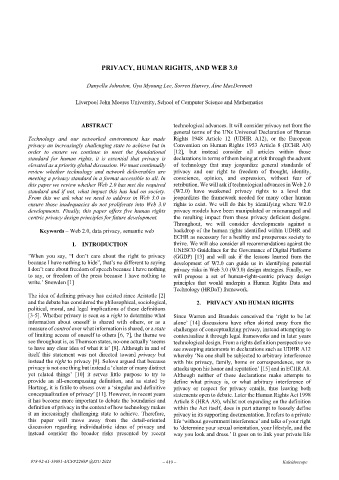Page 463 - Kaleidoscope Academic Conference Proceedings 2024
P. 463
PRIVACY, HUMAN RIGHTS, AND WEB 3.0
Danyella Johnston, Gyu Myoung Lee, Sorren Hanvey, Áine MacDermott
Liverpool John Moores University, School of Computer Science and Mathematics
ABSTRACT technological advances. It will consider privacy not from the
general terms of the UNs Universal Declaration of Human
Technology and our networked environment has made Rights 1948 Article 12 (UDHR A12), or the European
privacy an increasingly challenging state to achieve but in Convention on Human Rights 1953 Article 8 (ECHR A8)
order to ensure we continue to meet the foundational [12], but instead consider all articles within those
standard for human rights, it is essential that privacy is declarations in terms of them being at risk through the advent
elevated as a priority global discussion. We must continually of technology that may jeopardize general standards of
review whether technology and network deliverables are privacy and our right to freedom of thought, identity,
meeting a privacy standard in a format accessible to all. In conscience, opinion, and expression, without fear of
this paper we review whether Web 2.0 has met the required retribution. We will ask if technological advances in Web 2.0
standard and if not, what impact this has had on society. (W2.0) have weakened privacy rights to a level that
From this we ask what we need to address in Web 3.0 to jeopardizes the framework needed for many other human
ensure those inadequacies do not proliferate into Web 3.0 rights to exist. We will do this by identifying where W2.0
developments. Finally, this paper offers five human rights privacy models have been manipulated or mismanaged and
centric privacy design principles for future development. the resulting impact from those privacy deficient designs.
Throughout, we will consider developments against a
Keywords – Web 2.0, data privacy, semantic web backdrop of the human rights identified within UDHR and
ECHR as necessary for a healthy and prosperous society to
1. INTRODUCTION thrive. We will also consider all recommendations against the
UNESCO Guidelines for the Governance of Digital Platforms
‘When you say, “I don’t care about the right to privacy (GGDP) [13] and will ask if the lessons learned from the
because I have nothing to hide”, that’s no different to saying development of W2.0 can guide us in identifying potential
I don’t care about freedom of speech because I have nothing privacy risks in Web 3.0 (W3.0) design strategies. Finally, we
to say, or freedom of the press because I have nothing to will propose a set of human-rights-centric privacy design
write.’ Snowden [1] principles that would underpin a Human Rights Data and
Technology (HRDaT) framework.
The idea of defining privacy has existed since Aristotle [2]
and the debate has considered the philosophical, sociological, 2. PRIVACY AND HUMAN RIGHTS
political, moral, and legal implications of these definitions
[3-5]. Whether privacy is seen as a right to determine what Since Warren and Brandeis conceived the ‘right to be let
information about oneself is shared with others, or as a alone’ [14] discussions have often skirted away from the
measure of control over what information is shared, or a state challenges of conceptualizing privacy, instead attempting to
of limiting access of oneself to others [6, 7], the theme we contextualize it through legal frameworks and in later years
see throughout is, as Thomson states, no-one actually ‘seems technological design. From a rights definition perspective we
to have any clear idea of what it is’ [8]. Although in and of see sweeping statements in declarations such as UDHR A12
itself this statement was not directed toward privacy but whereby ‘No one shall be subjected to arbitrary interference
instead the right to privacy [9]. Solove argued that because with his privacy, family, home or correspondence, nor to
privacy is not one thing but instead a ‘cluster of many distinct attacks upon his honor and reputation’ [15] and in ECHR A8.
yet related things’ [10] it serves little purpose to try to Although neither of these declarations make attempts to
provide an all-encompassing definition, and as stated by define what privacy is, or what arbitrary interference of
Hartzog, it is futile to obsess over a ‘singular and definitive privacy or respect for privacy entails, thus leaving both
conceptualization of privacy’ [11]. However, in recent years statements open to debate. Later the Human Rights Act 1998
it has become more important to debate the boundaries and Article 8 (HRA A8), whilst not expanding on the definition
definition of privacy in the context of how technology makes within the Act itself, does in part attempt to loosely define
it an increasingly challenging state to achieve. Therefore, privacy in its supporting documentation. It refers to a private
this paper will move away from the detail-oriented life ‘without government interference’ and talks of your right
discussion regarding individualistic ideas of privacy and to ‘determine your sexual orientation, your lifestyle, and the
instead consider the broader risks presented by recent way you look and dress.’ It goes on to link your private life
978-92-61-39091-4/CFP2268P @ITU 2024 – 419 – Kaleidoscope

